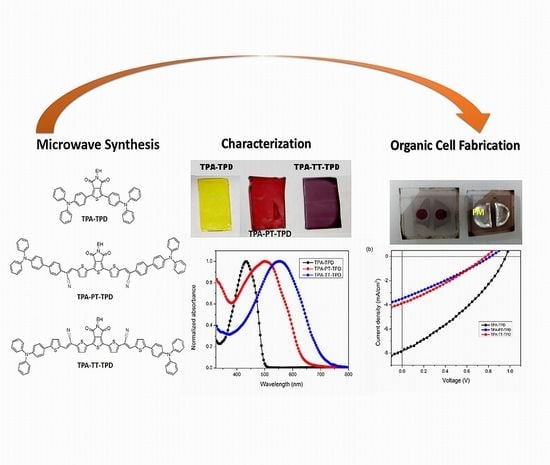Small Molecules Derived from Thieno[3,4-c]pyrrole-4,6-dione (TPD) and Their Use in Solution Processed Organic Solar Cells
Abstract
:1. Introduction
2. Results and Discussion
2.1. Synthesis and Characterization
2.2. Theoretical Calculations
2.3. Optical Properties
2.4. Electrochemical Properties
2.5. Photovoltaic Performance
2.6. Morphological Analysis
3. Materials and Methods
3.1. Materials
3.2. Characterization
3.3. Synthesis
3.3.1. Knoevenagel Reaction
3.3.2. General Method for Suzuki Reaction
3.3.3. Direct Arylation
4. Conclusions
Supplementary Materials
Acknowledgments
Author Contributions
Conflicts of Interest
References
- Yang, J.; Yan, D.; Jones, T.S. Molecular Template Growth and Its Applications in Organic Electronics and Optoelectronics. Chem. Rev. 2015, 115, 5570–5603. [Google Scholar] [CrossRef] [PubMed]
- Heeger, A.J. Semiconducting polymers: The Third Generation. Chem. Soc. Rev. 2010, 39, 2354–2371. [Google Scholar] [CrossRef] [PubMed]
- Dou, L.; Liu, Y.; Hong, Z.; Li, G.; Yang, Y. Low-Bandgap Near-IR Conjugated Polymers/Molecules for Organic Electronics. Chem. Rev. 2015, 115, 12633–12665. [Google Scholar] [CrossRef] [PubMed]
- Figueira-Duarte, T.M.; Müllen, K. Pyrene-Based Materials for Organic Electronics. Chem. Rev. 2011, 111, 7260–7314. [Google Scholar] [CrossRef] [PubMed]
- Li, J.; Zhang, Q. Linearly Fused Azaacenes: Novel Approaches and New Applications Beyond Field-Effect Transistors (FETs). ACS Appl. Mater. Interfaces 2015, 7, 28049–28062. [Google Scholar] [CrossRef] [PubMed]
- Lin, Y.; Li, Y.; Zhan, X. Small molecule semiconductors for high-efficiency organic photovoltaics. Chem. Soc. Rev. 2012, 41, 4245–4272. [Google Scholar] [CrossRef] [PubMed]
- Mishra, A.; Bäuerle, P. Small Molecule Organic Semiconductors on the Move: Promises for Future Solar Energy Technology. Angew. Chem. Int. Ed. 2012, 51, 2020–2067. [Google Scholar] [CrossRef] [PubMed]
- Hains, A.W.; Liang, Z.; Woodhouse, M.A.; Gregg, B.A. Molecular Semiconductors in Organic Photovoltaic Cells. Chem. Rev. 2010, 110, 6689–6735. [Google Scholar] [CrossRef] [PubMed]
- Dou, L.; You, J.; Hong, Z.; Xu, Z.; Li, G.; Street, R.A.; Yang, Y. 25th Anniversary Article: A Decade of Organic/Polymeric Photovoltaic Research. Adv. Mater. 2013, 25, 6642–6671. [Google Scholar] [CrossRef] [PubMed]
- Allard, S.; Forster, M.; Souharce, B.; Thiem, H.; Scherf, U. Organic Semiconductors for Solution-Processable Field-Effect Transistors (OFETs). Angew. Chem. Int. Ed. 2008, 47, 4070–4098. [Google Scholar] [CrossRef] [PubMed]
- Sirringhaus, H. 25th Anniversary Article: Organic Field-Effect Transistors: The Path Beyond Amorphous Silicon. Adv. Mater. 2014, 26, 1319–1335. [Google Scholar] [CrossRef] [PubMed]
- Klauk, H. Organic thin-film transistors. Chem. Soc. Rev. 2010, 39, 2643–2666. [Google Scholar] [CrossRef] [PubMed]
- Duan, L.; Hou, L.; Lee, T.-W.; Qiao, J.; Zhang, D.; Dong, G.; Wang, L.; Qiu, Y. Solution processable small molecules for organic light-emitting diodes. J. Mater. Chem. 2010, 20, 6392–6407. [Google Scholar] [CrossRef]
- Tao, Y.; Yang, C.; Qin, J. Organic host materials for phosphorescent organic light-emitting diodes. Chem. Soc. Rev. 2011, 40, 2943–2970. [Google Scholar] [CrossRef] [PubMed]
- Xiao, L.; Chen, Z.; Qu, B.; Luo, J.; Kong, S.; Gong, Q.; Kido, J. Recent Progresses on Materials for Electrophosphorescent Organic Light-Emitting Devices. Adv. Mater. 2011, 23, 926–952. [Google Scholar] [CrossRef] [PubMed]
- Nielsen, T.D.; Cruickshank, C.; Foged, S.; Thorsen, J.; Krebs, F.C. Business, market and intellectual property analysis of polymer solar cells. Sol. Energy Mater. Sol. Cells 2010, 94, 1553–1571. [Google Scholar] [CrossRef]
- Espinosa, N.; Laurent, A.; Krebs, F.C. Ecodesign of organic photovoltaic modules from Danish and Chinese perspectives. Energy Environ. Sci. 2015, 8, 2537–2550. [Google Scholar] [CrossRef] [Green Version]
- Krebs, F.C. Fabrication and processing of polymer solar cells: A review of printing and coating techniques. Sol. Energy Mater. Sol. Cells 2009, 93, 394–412. [Google Scholar] [CrossRef]
- Krebs, F.C.; Espinosa, N.; Hösel, M.; Søndergaard, R.R.; Jørgensen, M. 25th Anniversary Article: Rise to Power—OPV-Based Solar Parks. Adv. Mater. 2014, 26, 29–39. [Google Scholar] [CrossRef] [PubMed]
- Andersen, T.R.; Dam, H.F.; Hosel, M.; Helgesen, M.; Carle, J.E.; Larsen-Olsen, T.T.; Gevorgyan, S.A.; Andreasen, J.W.; Adams, J.; Li, N.; et al. Scalable, Ambient Atmosphere Roll-to-Roll Manufacture of Encapsulated Large Area, Flexible Organic Tandem Solar Cell Modules. Energy Environ. Sci. 2014, 7, 2925–2933. [Google Scholar] [CrossRef]
- Kang, H.; Kim, G.; Kim, J.; Kwon, S.; Kim, H.; Lee, K. Bulk-Heterojunction Organic Solar Cells: Five Core Technologies for Their Commercialization. Adv. Mater. 2016, 28, 7821–7861. [Google Scholar] [CrossRef] [PubMed]
- Po, R.; Bianchi, G.; Carbonera, C.; Pellegrino, A. “All That Glisters Is Not Gold”: An Analysis of the Synthetic Complexity of Efficient Polymer Donors for Polymer Solar Cells. Macromolecules 2015, 48, 453–461. [Google Scholar] [CrossRef]
- Chen, Y.; Wan, X.; Long, G. High Performance Photovoltaic Applications Using Solution-Processed Small Molecules. Acc. Chem. Res. 2013, 46, 2645–2655. [Google Scholar] [CrossRef] [PubMed]
- Ni, W.; Wan, X.; Li, M.; Wang, Y.; Chen, Y. A-D-A small molecules for solution-processed organic photovoltaic cells. Chem. Commun. 2015, 51, 4936–4950. [Google Scholar] [CrossRef] [PubMed]
- Bürckstümmer, H.; Tulyakova, E.V.; Deppisch, M.; Lenze, M.R.; Kronenberg, N.M.; Gsänger, M.; Stolte, M.; Meerholz, K.; Würthner, F. Efficient Solution-Processed Bulk Heterojunction Solar Cells by Antiparallel Supramolecular Arrangement of Dipolar Donor–Acceptor Dyes. Angew. Chem. Int. Ed. 2011, 50, 11628–11632. [Google Scholar] [CrossRef] [PubMed]
- Lu, L.; Zheng, T.; Wu, Q.; Schneider, A.M.; Zhao, D.; Yu, L. Recent Advances in Bulk Heterojunction Polymer Solar Cells. Chem. Rev. 2015, 115, 12666–12731. [Google Scholar] [CrossRef] [PubMed]
- Zhou, H.; Yang, L.; You, W. Rational Design of High Performance Conjugated Polymers for Organic Solar Cells. Macromolecules 2012, 45, 607–632. [Google Scholar] [CrossRef]
- Guo, X.; Zhou, N.; Lou, S.J.; Hennek, J.W.; Ortiz, R.P.; Butler, M.R.; Boudreault, P.-L.T.; Strzalka, J.; Morin, P.-O.; Leclerc, M.; et al. Bithiopheneimide–Dithienosilole/Dithienogermole Copolymers for Efficient Solar Cells: Information from Structure–Property–Device Performance Correlations and Comparison to Thieno[3,4-c]pyrrole-4,6-dione Analogues. J. Am. Chem. Soc. 2012, 134, 18427–18439. [Google Scholar] [CrossRef] [PubMed]
- Cheon, Y.R.; Kim, Y.J.; Ha, J.; Kim, M.-J.; Park, C.E.; Kim, Y.-H. TPD-Based Copolymers with Strong Interchain Aggregation and High Hole Mobility for Efficient Bulk Heterojunction Solar Cells. Macromolecules 2014, 47, 8570–8577. [Google Scholar] [CrossRef]
- Chung, H.-S.; Lee, W.-H.; Song, C.E.; Shin, Y.; Kim, J.; Lee, S.K.; Shin, W.S.; Moon, S.-J.; Kang, I.-N. Highly Conjugated Side-Chain-Substituted Benzo[1,2-b:4,5-b′]dithiophene-Based Conjugated Polymers for Use in Polymer Solar Cells. Macromolecules 2014, 47, 97–105. [Google Scholar] [CrossRef]
- Najari, A.; Beaupré, S.; Berrouard, P.; Zou, Y.; Pouliot, J.-R.; Lepage-Pérusse, C.; Leclerc, M. Synthesis and Characterization of New Thieno[3,4-c]pyrrole-4,6-dione Derivatives for Photovoltaic Applications. Adv. Funct. Mater. 2011, 21, 718–728. [Google Scholar] [CrossRef]
- Zhou, N.; Guo, X.; Ortiz, R.P.; Harschneck, T.; Manley, E.F.; Lou, S.J.; Hartnett, P.E.; Yu, X.; Horwitz, N.E.; Burrezo, P.M.; et al. Marked Consequences of Systematic Oligothiophene Catenation in Thieno[3,4-c]pyrrole-4,6-dione and Bithiopheneimide Photovoltaic Copolymers. J. Am. Chem. Soc. 2015, 137, 12565–12579. [Google Scholar] [CrossRef] [PubMed]
- Stalder, R.; Mei, J.; Graham, K.R.; Estrada, L.A.; Reynolds, J.R. Isoindigo, a Versatile Electron-Deficient Unit For High-Performance Organic Electronics. Chem. Mater. 2014, 26, 664–678. [Google Scholar] [CrossRef]
- Lee, O.P.; Yiu, A.T.; Beaujuge, P.M.; Woo, C.H.; Holcombe, T.W.; Millstone, J.E.; Douglas, J.D.; Chen, M.S.; Fréchet, J.M.J. Efficient Small Molecule Bulk Heterojunction Solar Cells with High Fill Factors via Pyrene-Directed Molecular Self-Assembly. Adv. Mater. 2011, 23, 5359–5363. [Google Scholar] [CrossRef] [PubMed]
- Najari, A.; Berrouard, P.; Ottone, C.; Boivin, M.; Zou, Y.; Gendron, D.; Caron, W.-O.; Legros, P.; Allen, C.N.; Sadki, S.; et al. High Open-Circuit Voltage Solar Cells Based on New Thieno[3,4-c]pyrrole-4,6-dione and 2,7-Carbazole Copolymers. Macromolecules 2012, 45, 1833–1838. [Google Scholar] [CrossRef]
- Choi, Y.S.; Shin, T.J.; Jo, W.H. Small Molecules Based on Thieno[3,4-c]pyrrole-4,6-dione for High Open-Circuit Voltage (VOC) Organic Photovoltaics: Effect of Different Positions of Alkyl Substitution on Molecular Packing and Photovoltaic Performance. ACS Appl. Mater. Interfaces 2014, 6, 20035–20042. [Google Scholar] [CrossRef] [PubMed]
- Liu, X.; Sun, Y.; Hsu, B.B.Y.; Lorbach, A.; Qi, L.; Heeger, A.J.; Bazan, G.C. Design and Properties of Intermediate-Sized Narrow Band-Gap Conjugated Molecules Relevant to Solution-Processed Organic Solar Cells. J. Am. Chem. Soc. 2014, 136, 5697–5708. [Google Scholar] [CrossRef] [PubMed]
- Lin, Y.; Cheng, P.; Liu, Y.; Zhao, X.; Li, D.; Tan, J.; Hu, W.; Li, Y.; Zhan, X. Solution-processable small molecules based on thieno[3,4-c]pyrrole-4,6-dione for high-performance solar cells. Sol. Energy Mater. Sol. Cells 2012, 99, 301–307. [Google Scholar] [CrossRef]
- Ning, Z.; Tian, H. Triarylamine: A promising core unit for efficient photovoltaic materials. Chem. Commun. 2009, 5483–5495. [Google Scholar] [CrossRef] [PubMed]
- Zhang, Z.; Zhou, Z.; Hu, Q.; Liu, F.; Russell, T.P.; Zhu, X. 1,3-Bis(thieno[3,4-b]thiophen-6-yl)-4H-thieno[3,4-c]pyrrole-4,6(5H)-dione-Based Small-Molecule Donor for Efficient Solution-Processed Solar Cells. ACS Appl. Mater. Interfaces 2017, 9, 6213–6219. [Google Scholar] [CrossRef] [PubMed]
- Pérez-Gutiérrez, E.; Lozano, J.; Gaspar-Tánori, J.; Maldonado, J.-L.; Gómez, B.; López, L.; Amores-Tapia, L.-F.; Barbosa-García, O.; Percino, M.-J. Organic solar cells all made by blade and slot–die coating techniques. Sol. Energy 2017, 146, 79–84. [Google Scholar] [CrossRef]
- Barreiro-Argüelles, D.; Ramos-Ortiz, G.; Maldonado, J.L.; Pérez-Gutiérrez, E.; Romero-Borja, D.; Álvarez-Fernández, A. PTB7:PC71BM-Based Solar Cells Fabricated With the Eutectic Alloy Field’s Metal as an Alternative Cathode and the Influence of an Electron Extraction Layer. IEEE J. Photovolt. 2017, 7, 191–198. [Google Scholar] [CrossRef]
- Pérez-Gutiérrez, E.; Barreiro-Argüelles, D.; Maldonado, J.-L.; Meneses-Nava, M.-A.; Barbosa-García, O.; Ramos-Ortíz, G.; Rodríguez, M.; Fuentes-Hernández, C. Semiconductor Polymer/Top Electrode Interface Generated by Two Deposition Methods and Its Influence on Organic Solar Cell Performance. ACS Appl. Mater. Interfaces 2016, 8, 28763–28770. [Google Scholar] [CrossRef] [PubMed]
- Chang, S.-Y.; Lin, P.-H.; Liu, C.-Y. Pd-catalyzed Direct C–H Arylation of thieno[3,4-c]pyrrole-4,6-dione (TPD): A Step-Economical Synthetic Alternative to Access TPD-centred Symmetrical Small Molecules. RSC Adv. 2014, 4, 35868–35878. [Google Scholar] [CrossRef]
- Yin, L.; Liebscher, J. Carbon–Carbon Coupling Reactions Catalyzed by Heterogeneous Palladium Catalysts. Chem. Rev. 2007, 107, 133–173. [Google Scholar] [CrossRef] [PubMed]
- Creamer, A.; Casey, A.; Marsh, A.V.; Shahid, M.; Gao, M.; Heeney, M. Systematic Tuning of 2,1,3-Benzothiadiazole Acceptor Strength by Monofunctionalization with Alkylamine, Thioalkyl, or Alkoxy Groups in Carbazole Donor-Acceptor Polymers. Macromolecules 2017, 50, 2736–2746. [Google Scholar] [CrossRef]
- Frisch, M.J.; Trucks, G.W.; Schlegel, H.B.; Scuseria, G.E.; Robb, M.A.; Cheeseman, J.R.; Scalmani, G.; Barone, V.; Petersson, G.A.; Nakatsuji, H.; et al. Gaussian 09, Revision A.02; Gaussian, Inc.: Wallingford, CT, USA, 2016.
- Zhan, C.G.; Nichols, J.A.; Dixon, D.A. Ionization potential, electron affinity, electronegativity, hardness, and electron excitation energy: Molecular properties from density functional theory orbital energies. J. Phys. Chem. A 2003, 107, 4184–4195. [Google Scholar] [CrossRef]
- Zhang, Z.; Zhang, Y.; Yao, D.; Bi, H.; Javed, I.; Fan, Y.; Zhang, H.; Wang, Y. Anthracene-Arrangement-Dependent Emissions of Crystals of 9-Anthrylpyrazole Derivatives. Cryst. Growth Des. 2009, 9, 5069–5076. [Google Scholar] [CrossRef]
- Cardona, C.M.; Li, W.; Kaifer, A.E.; Stockdale, D.; Bazan, G.C. Electrochemical Considerations for Determining Absolute Frontier Orbital Energy Levels of Conjugated Polymers for Solar Cell Applications. Adv. Mater. 2011, 23, 2367–2371. [Google Scholar] [CrossRef] [PubMed]
- Kim, Y.J.; Baek, J.Y.; Ha, J.; Chung, D.S.; Kwon, S.-K.; Park, C.E.; Kim, Y.-H. A high-performance solution-processed small molecule: Alkylselenophene-substituted benzodithiophene organic solar cell. J. Mater. Chem. C 2014, 2, 4937–4946. [Google Scholar] [CrossRef]
- Schulz, G.L.; Fischer, F.S.U.; Trefz, D.; Melnyk, A.; Hamidi-Sakr, A.; Brinkmann, M.; Andrienko, D.; Ludwigs, S. The PCPDTBT Family: Correlations between Chemical Structure, Polymorphism, and Device Performance. Macromolecules 2017, 50, 1402–1414. [Google Scholar] [CrossRef]
- Qin, T.; Troisi, A. Relation Between Structure and Electronic Properties of Amorphous MEH-PPV Polymers. J. Am. Chem. Soc. 2013, 135, 11247–11256. [Google Scholar] [CrossRef] [PubMed]
- Kim, M.-S.; Kim, B.-G.; Kim, J. Effective Variables To Control the Fill Factor of Organic Photovoltaic Cells. ACS Appl. Mater. Interfaces 2009, 1, 1264–1269. [Google Scholar] [CrossRef] [PubMed]
- Kong, J.; Hwang, I.-W.; Lee, K. Top-Down Approach for Nanophase Reconstruction in Bulk Heterojunction Solar Cells. Adv. Mater. 2014, 26, 6275–6283. [Google Scholar] [CrossRef] [PubMed]
- Wang, T.; Scarratt, N.W.; Yi, H.; Coleman, I.F.; Zhang, Y.; Grant, R.T.; Yao, J.; Skoda, M.W.A.; Dunbar, A.D.F.; Jones, R.A.L.; et al. Vertical stratification and its impact on device performance in a polycarbazole based copolymer solar cells. J. Mater. Chem. C 2015, 3, 4007–4015. [Google Scholar] [CrossRef]
- Di Nuzzo, D.; Aguirre, A.; Shahid, M.; Gevaerts, V.S.; Meskers, S.C.J.; Janssen, R.A.J. Improved Film Morphology Reduces Charge Carrier Recombination into the Triplet Excited State in a Small Bandgap Polymer-Fullerene Photovoltaic Cell. Adv. Mater. 2010, 22, 4321–4324. [Google Scholar] [CrossRef] [PubMed]
- Lombeck, F.; Komber, H.; Gorelsky, S.I.; Sommer, M. Identifying Homocouplings as Critical Side Reactions in Direct Arylation Polycondensation. ACS Macro Lett. 2014, 3, 819–823. [Google Scholar] [CrossRef]
Sample Availability: Samples of the compounds TPA-TPD, TPA-PT-TPD and TPA-TT-TPD, are available from the authors. |
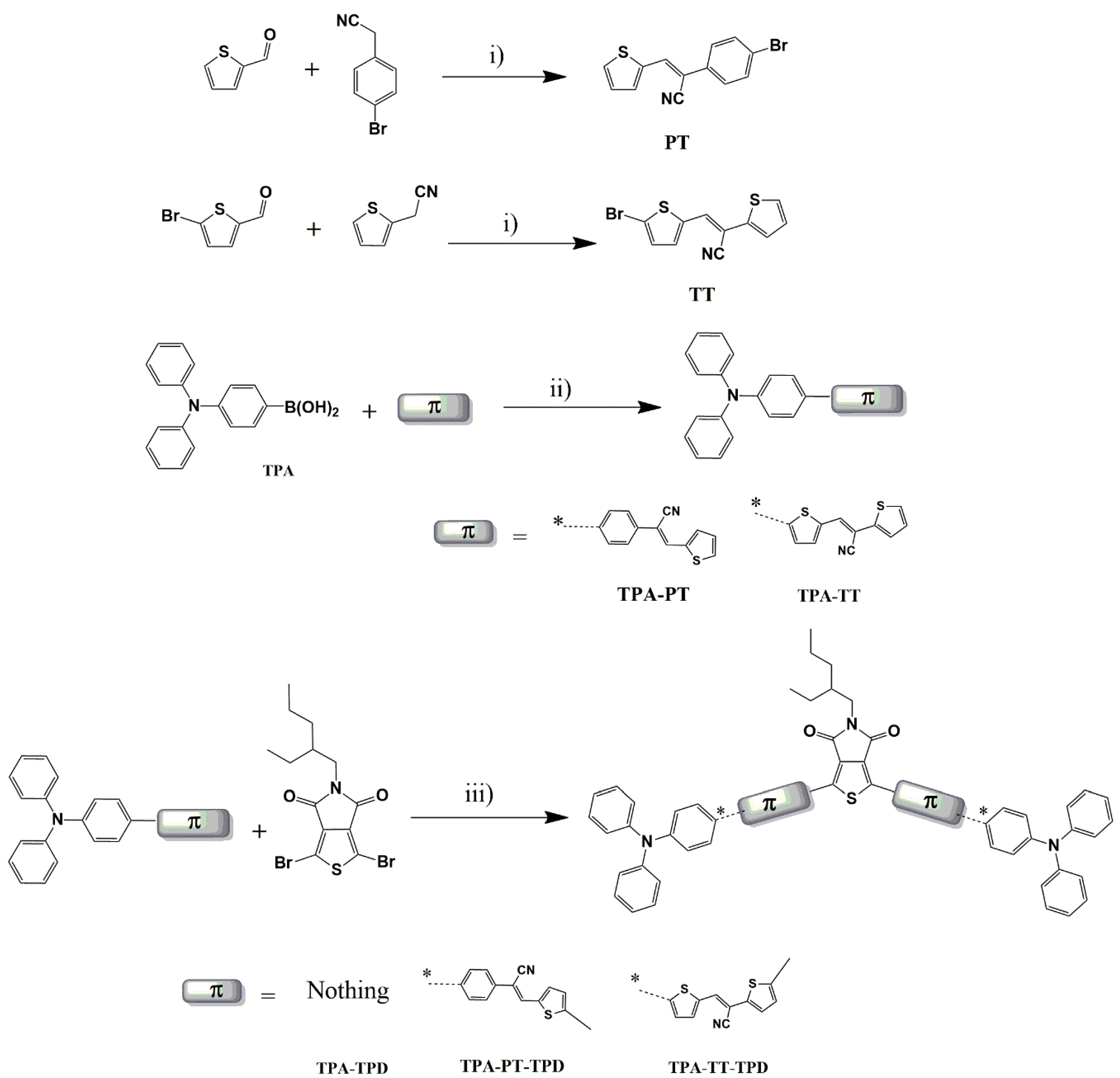
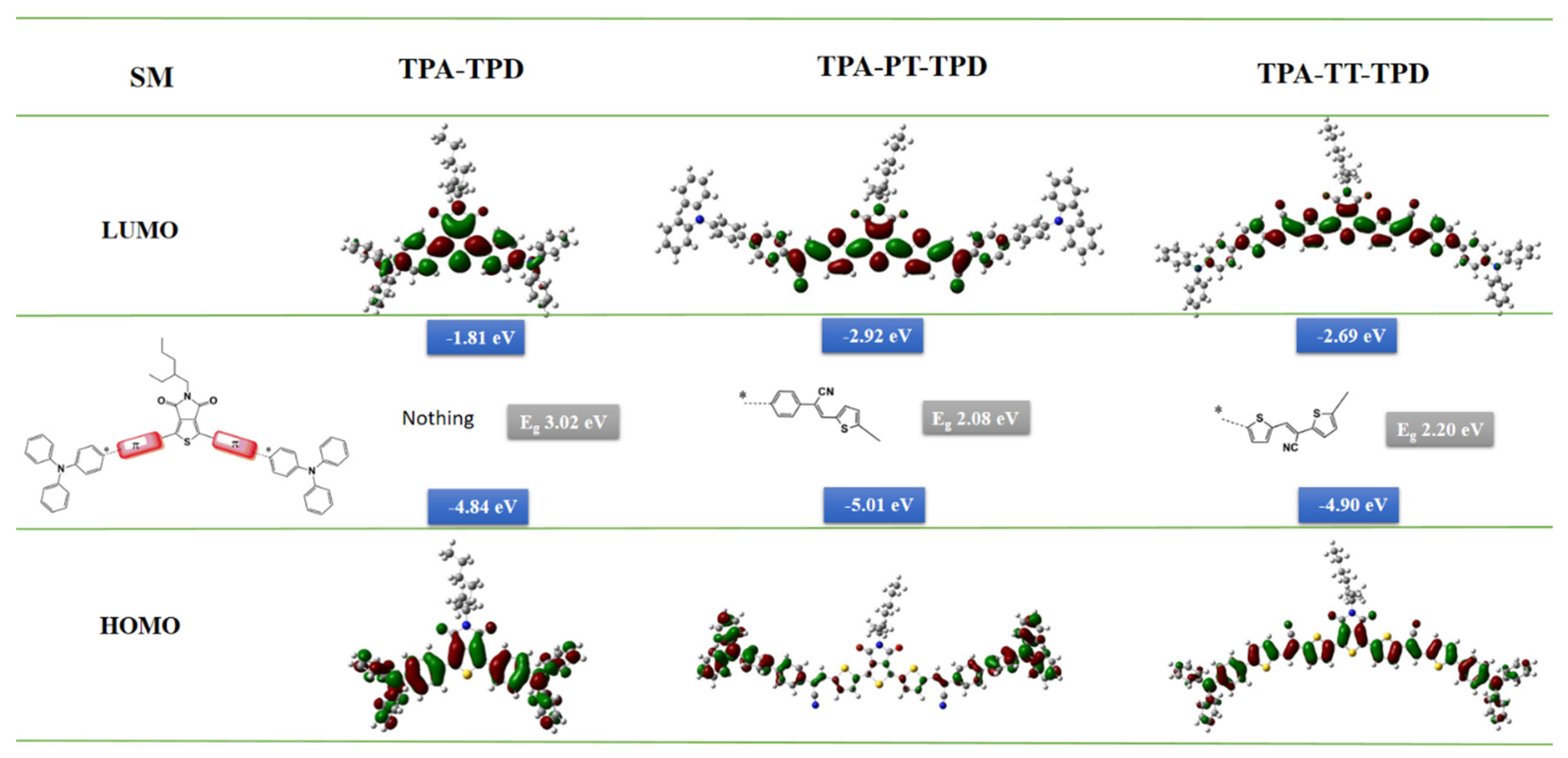
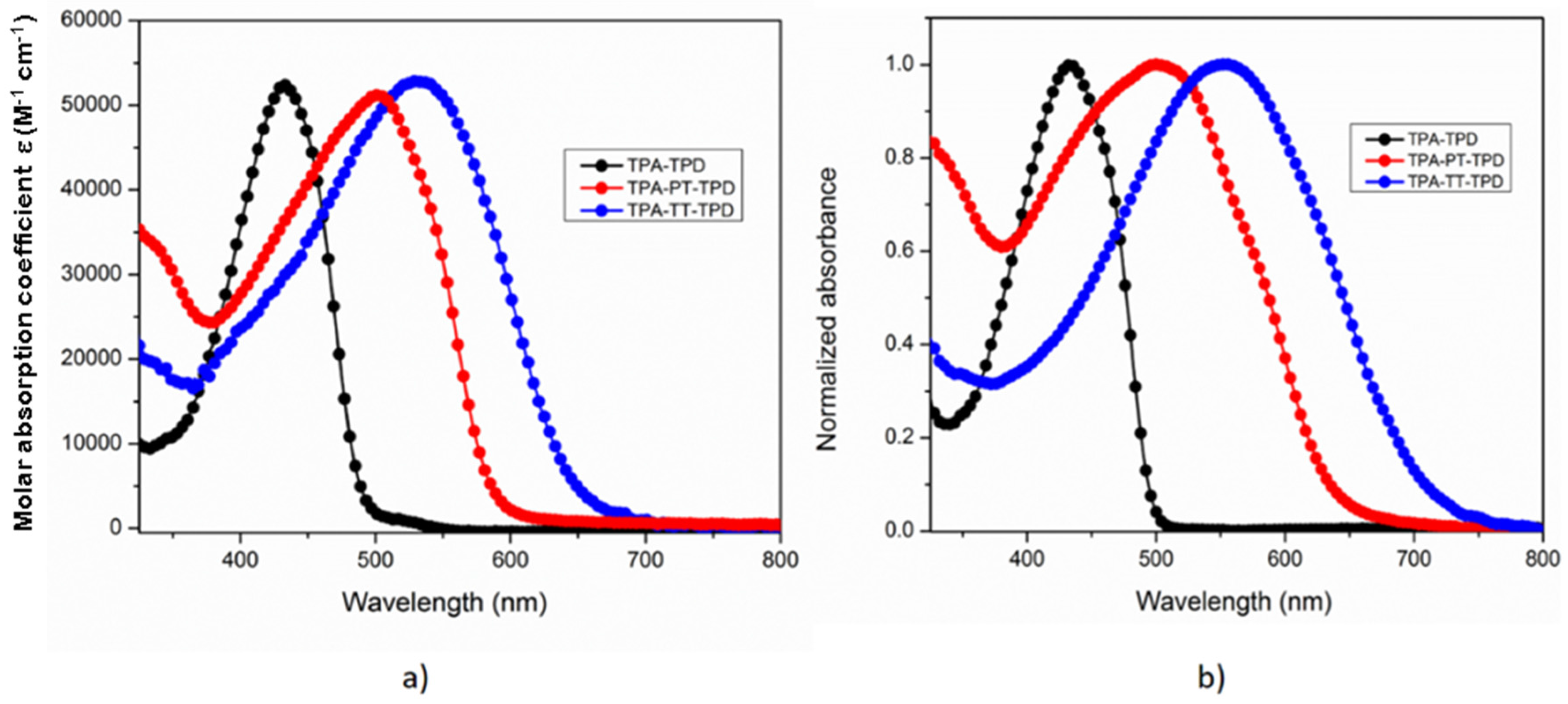
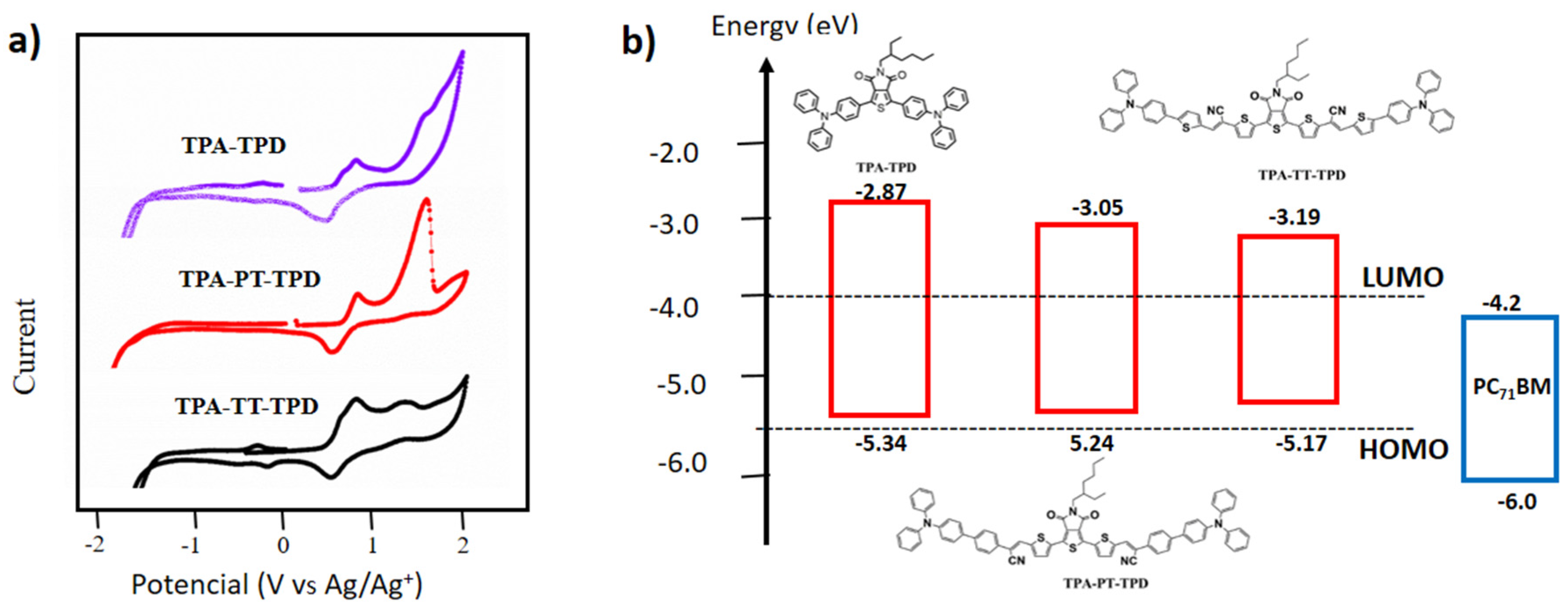
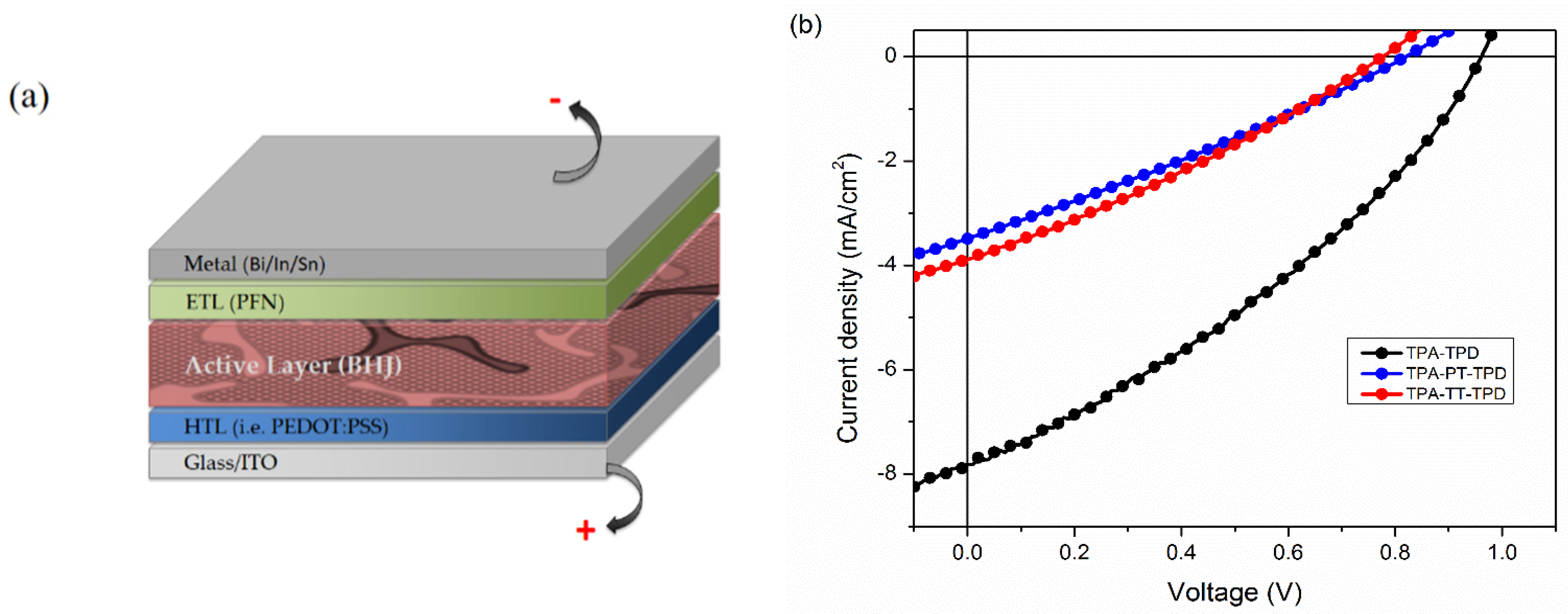

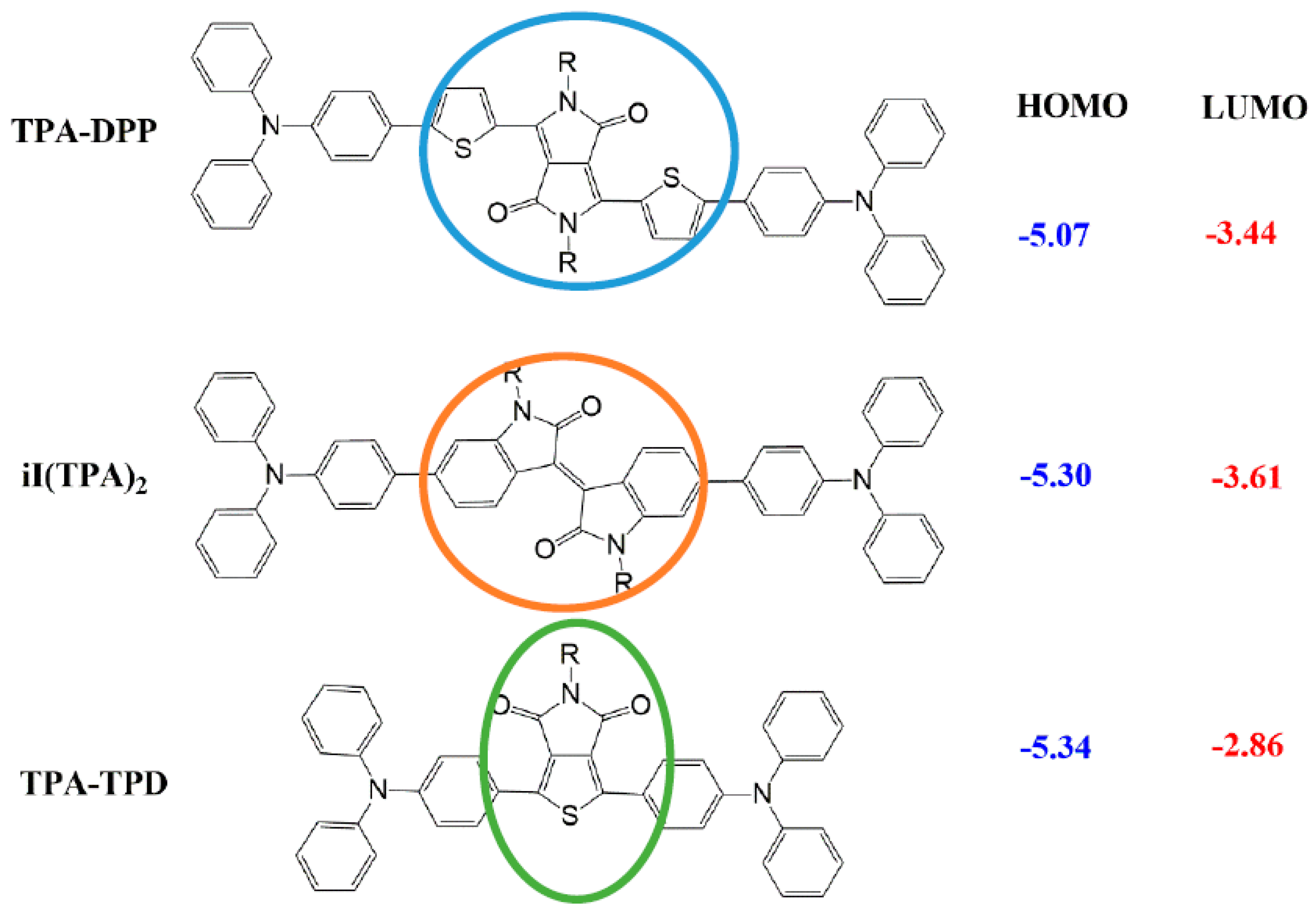
| SM | λmax (nm) a | λmax (nm) b | ε (M−1 cm−1) | Egopt (eV) c | EH (eV) | EL (eV) | Egelec (eV) |
|---|---|---|---|---|---|---|---|
| TPA-TPD | 433 | 434 | 52,382 | 2.48 | −5.34 | −2.87 | 2.47 |
| TPA-PT-TPD | 495 | 500 | 51,200 | 1.90 | −5.24 | −3.05 | 2.19 |
| TPA-TT-TPD | 527 | 551 | 52,892 | 1.74 | −5.17 | −3.19 | 1.98 |
| SM | Ratio D:A | Thickness (a) (nm) | JSC (mA/cm2) | VOC (V) | FF | PCE % |
|---|---|---|---|---|---|---|
| TPA-TPD | 1:4 | ~78 | 7.3 ± 0.5 (7.9) | 0.97 ± 0.02 (0.99) | 0.33 ± 0.01 (0.34) | 2.32 ±0.28 (2.6) |
| TPA-PT-TPD | 1:3 | ~80 | 3.1 ± 0.4 (3.5) | 0.80 ± 0.02 (0.82) | 0.27 ± 0.01 (0.28) | 0.67 ± 0.12 (0.79) |
| TPA-TT-TPD | 1:2 | ~79 | 3.6 ± 0.41 (4.1) | 0.74 ± 0.14 (0.89) | 0.30 ± 0.03 (0.33) | 0.81 ± 0.10 (0.91) |
| Donor | Acceptor | D:A (w/w) | JSC (mA/cm2) | VOC (V) | FF | PCE (%) | HOMO/LUMO (eV) | Ref. |
|---|---|---|---|---|---|---|---|---|
| iI(TPA)2 | PC61BM | 1:3 | 2.9 | 0.78 | 0.37 | 0.84 | −5.30/−3.61 | [33] |
| TPA-DPP | PC71BM | 1:4 | 4.3 | 0.73 | 0.30 | 1.0 | −5.07/−3.44 | [34] |
| TPA-TPD | PC71BM | 1:4 | 7.9 | 0.97 | 0.34 | 2.6 | −5.34/−2.86 | This work |
© 2017 by the authors. Licensee MDPI, Basel, Switzerland. This article is an open access article distributed under the terms and conditions of the Creative Commons Attribution (CC BY) license (http://creativecommons.org/licenses/by/4.0/).
Share and Cite
Garcias-Morales, C.; Romero-Borja, D.; Maldonado, J.-L.; Roa, A.E.; Rodríguez, M.; García-Merinos, J.P.; Ariza-Castolo, A. Small Molecules Derived from Thieno[3,4-c]pyrrole-4,6-dione (TPD) and Their Use in Solution Processed Organic Solar Cells. Molecules 2017, 22, 1607. https://doi.org/10.3390/molecules22101607
Garcias-Morales C, Romero-Borja D, Maldonado J-L, Roa AE, Rodríguez M, García-Merinos JP, Ariza-Castolo A. Small Molecules Derived from Thieno[3,4-c]pyrrole-4,6-dione (TPD) and Their Use in Solution Processed Organic Solar Cells. Molecules. 2017; 22(10):1607. https://doi.org/10.3390/molecules22101607
Chicago/Turabian StyleGarcias-Morales, Cesar, Daniel Romero-Borja, José-Luis Maldonado, Arián E. Roa, Mario Rodríguez, J. Pablo García-Merinos, and Armando Ariza-Castolo. 2017. "Small Molecules Derived from Thieno[3,4-c]pyrrole-4,6-dione (TPD) and Their Use in Solution Processed Organic Solar Cells" Molecules 22, no. 10: 1607. https://doi.org/10.3390/molecules22101607





